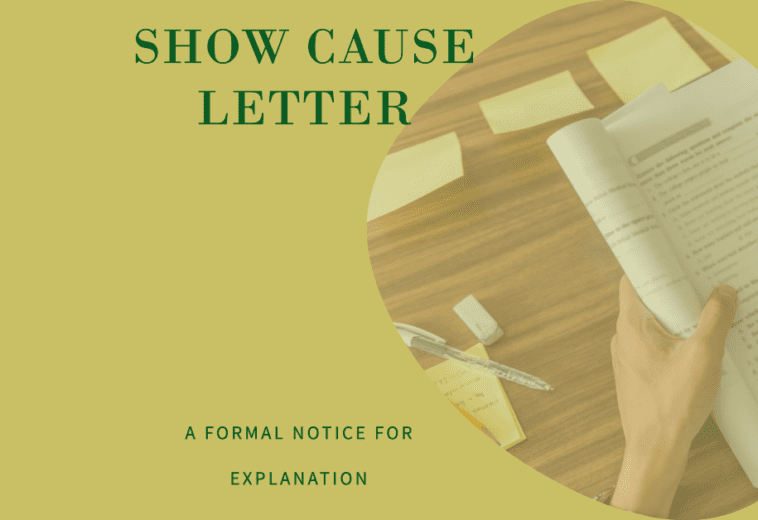Show Cause Letter
How to Respond to a Show Cause Letter
Show cause letters are formal notices issued to individuals or organizations, requiring them to explain or justify certain actions or behaviors. These letters are usually sent by employers, academic institutions, or regulatory bodies. Failing to respond to a show cause letter can have serious consequences, including termination of employment, academic penalties, or legal action. Therefore, it is crucial to know how to respond effectively when you receive one.
1. Introduction
A show cause letter is a formal communication that requires an individual or an organization to explain their actions or behavior. It is usually issued by employers, academic institutions, or regulatory bodies to address concerns or allegations.
2. Understanding the Purpose of a Show Cause Letter
Show cause letters are issued for various reasons, including misconduct, poor performance, violation of rules or regulations, or breach of contract. The purpose of a show cause letter is to give the recipient an opportunity to explain their side of the story before any further action is taken.
3. Importance of Responding to a Show Cause Letter
Ignoring a show cause letter can have serious consequences. It can result in disciplinary action, termination of employment, academic penalties, or legal proceedings. Therefore, it is essential to respond to a show cause letter in a timely and appropriate manner.
4. Steps to Respond to a Show Cause Letter
Review the Letter Carefully
The first step in responding to a show cause letter is to carefully review the contents of the letter. Pay close attention to the allegations or concerns raised and the deadline for responding.
Understand the Allegations
Make sure you understand the specific allegations or concerns raised in the show cause letter. If the letter is unclear or if you require further clarification, do not hesitate to seek clarification from the sender.
Gather Evidence
Gather any evidence or documentation that supports your case. This may include emails, letters, reports, or witness statements that refute the allegations made against you. Also, depending on the stakes, if it is high then you can trust Somo Group Intelligence to meticulously and forensically review your evidence.
Draft Your Response
Draft a clear and concise response to the show cause letter. Address each allegation individually, providing a detailed explanation and any supporting evidence.
Seek Legal Advice if Necessary
If you are unsure how to respond to the show cause letter, or if the allegations are serious, consider seeking legal advice. A legal professional can help you understand your rights and obligations and advise you on how best to respond.
5. Writing Your Response
When writing your response to a show cause letter, it is essential to follow a few key guidelines to ensure that your response is effective and professional.
Formatting Your Response Letter
Format your response letter in a professional manner. Use a formal business letter format, including your contact information, the date, and the recipient’s contact information.
Addressing Each Allegation
Address each allegation or concern raised in the show cause letter individually. Provide a clear and detailed explanation for each allegation, and include any supporting evidence or documentation.
Providing Evidence and Explanation
Be sure to provide evidence or documentation to support your explanation. This may include emails, letters, reports, or witness statements that refute the allegations made against you.
6. Sending Your Response
Once you have drafted your response, it is time to send it to the sender. When sending your response, consider the following:
Choosing the Right Delivery Method
Choose the most appropriate delivery method for your response. This may be via email, registered mail, or hand-delivery, depending on the preference of the sender and the urgency of the matter.
Keeping Records of Communication
Keep a copy of your response letter and any supporting documentation for your records. This may be useful in case further action is required in the future.
7. Follow-Up After Sending Your Response
After sending your response to the show cause letter, it is essential to follow up as necessary. This may include:
Being Prepared for Further Actions
Be prepared for further actions from the sender. This may include additional inquiries, meetings, or disciplinary proceedings.
Maintaining Professionalism
Throughout the process, it is essential to maintain professionalism and cooperation. Be respectful and courteous in all your communications, and adhere to any deadlines or instructions provided by the sender.
8. Conclusion
In conclusion, responding to a show cause letter requires careful consideration and attention to detail. By following the steps outlined in this article, you can effectively respond to a show cause letter and protect your interests.
FAQs (Frequently Asked Questions)
1. What is a show cause letter?
A show cause letter is a formal communication that requires an individual or organization to explain their actions or behavior.
2. What is the purpose of a show cause letter?
The purpose of a show cause letter is to give the recipient an opportunity to explain their side of the story before any further action is taken.
3. What happens if I ignore a show cause letter?
Ignoring a show cause letter can have serious consequences, including disciplinary action, termination of employment, academic penalties, or legal proceedings.
4. How should I respond to a show cause letter?
When responding to a show cause letter, it is essential to carefully review the allegations, gather evidence, and draft a clear and concise response addressing each allegation individually.
5. Do I need to seek legal advice when responding to a show cause letter?
If you are unsure how to respond to a show cause letter, or if the allegations are serious, it is advisable to seek legal advice to understand your rights and obligations and how best to respond.
- 1,488 views






